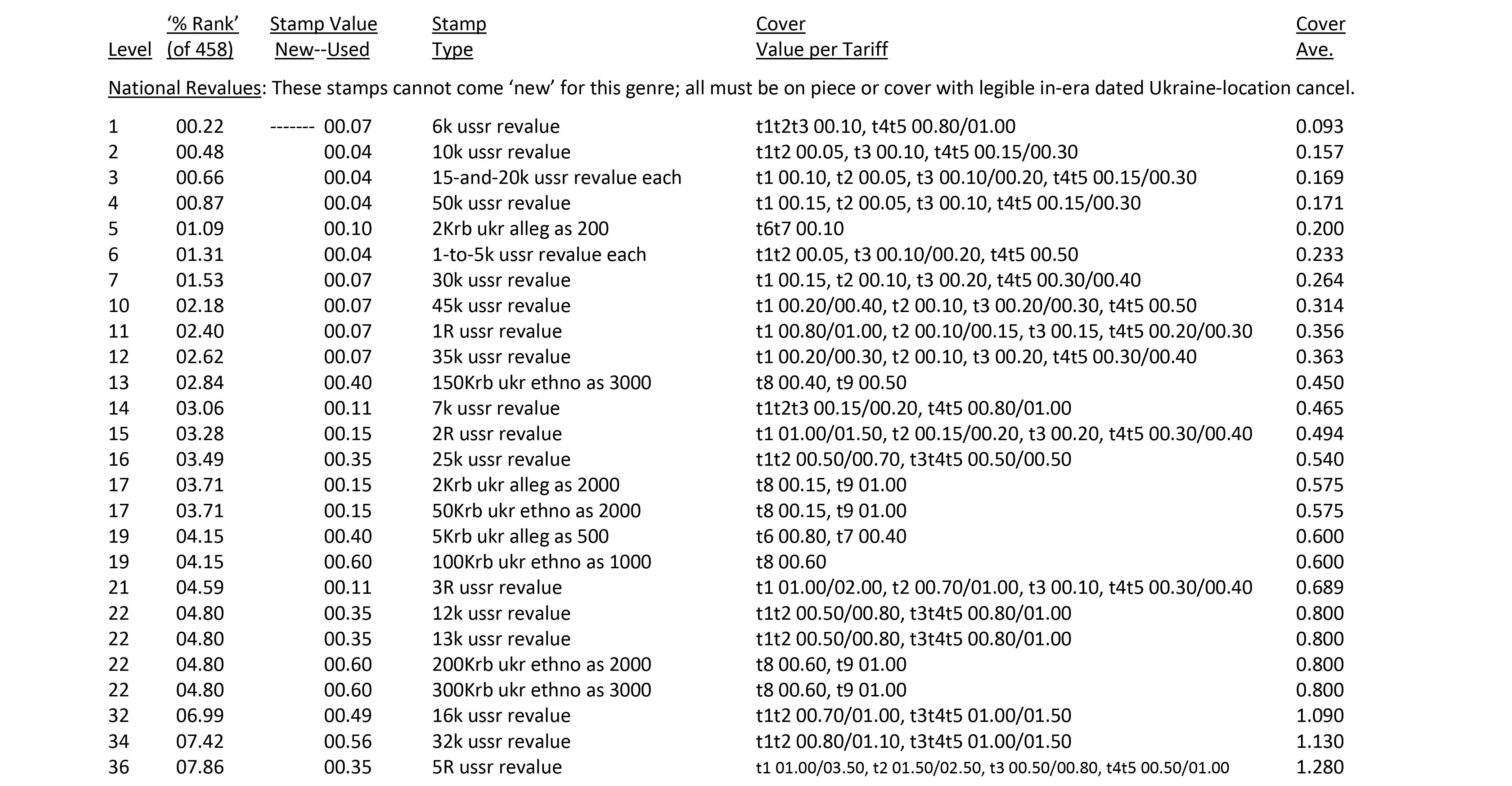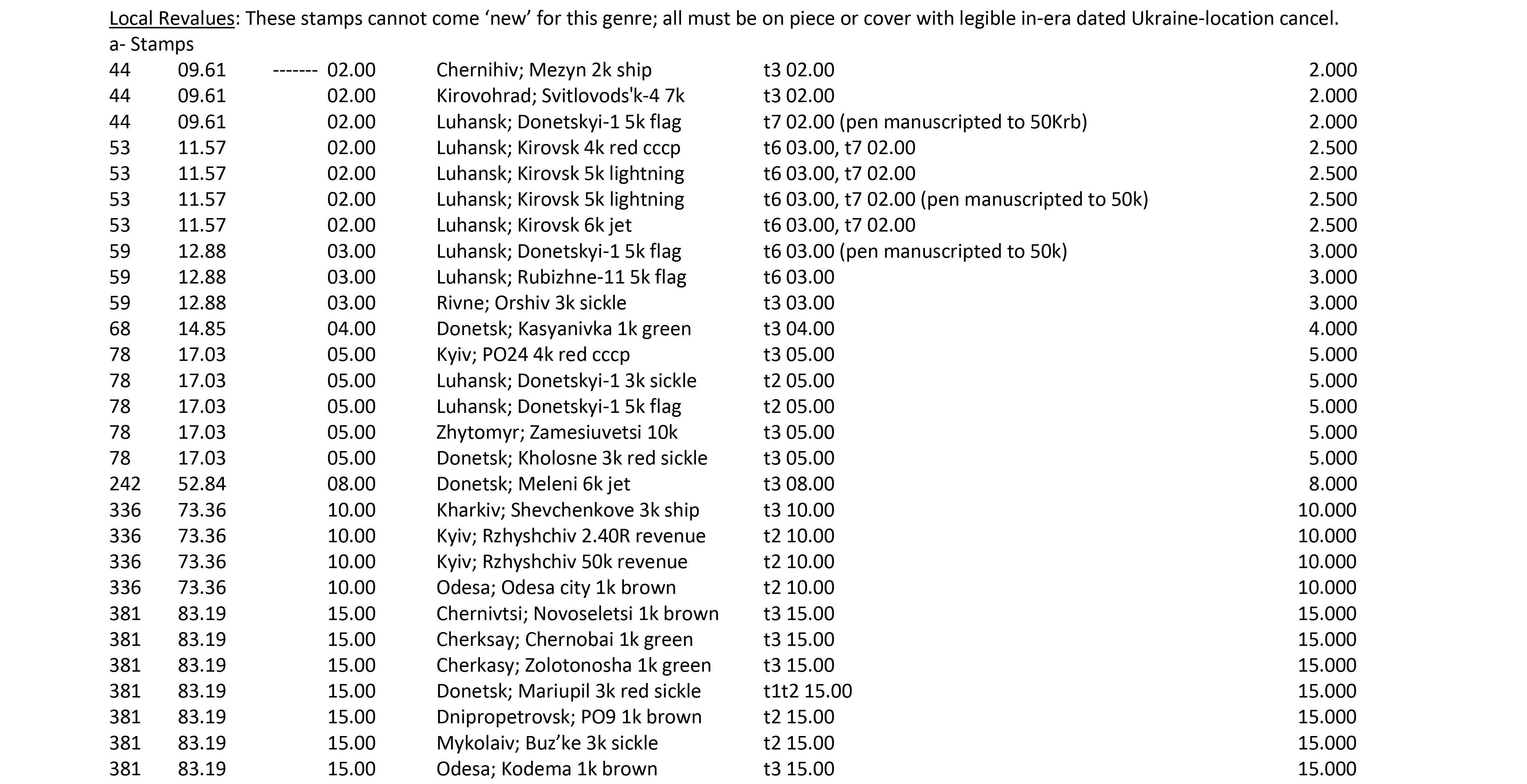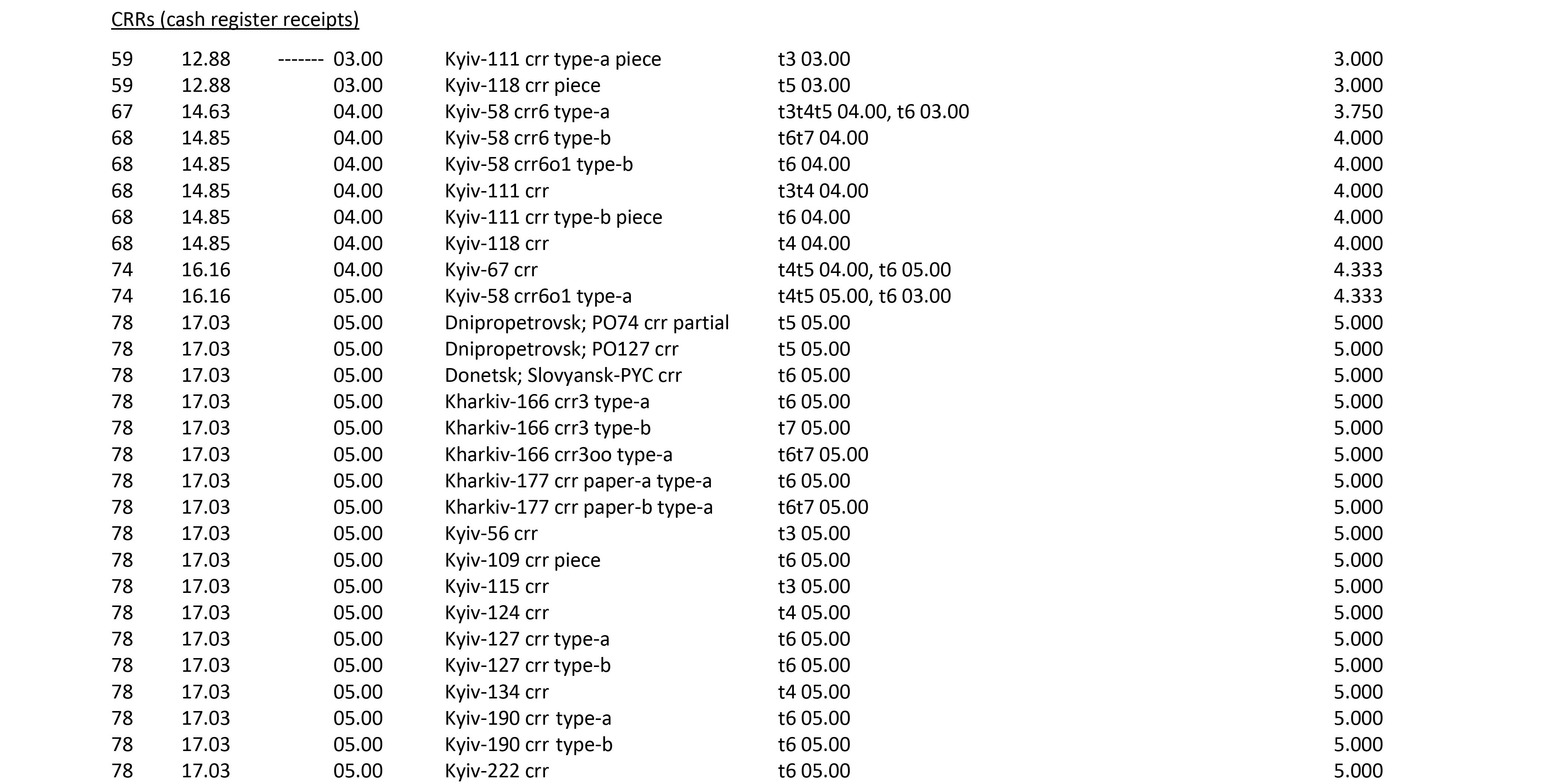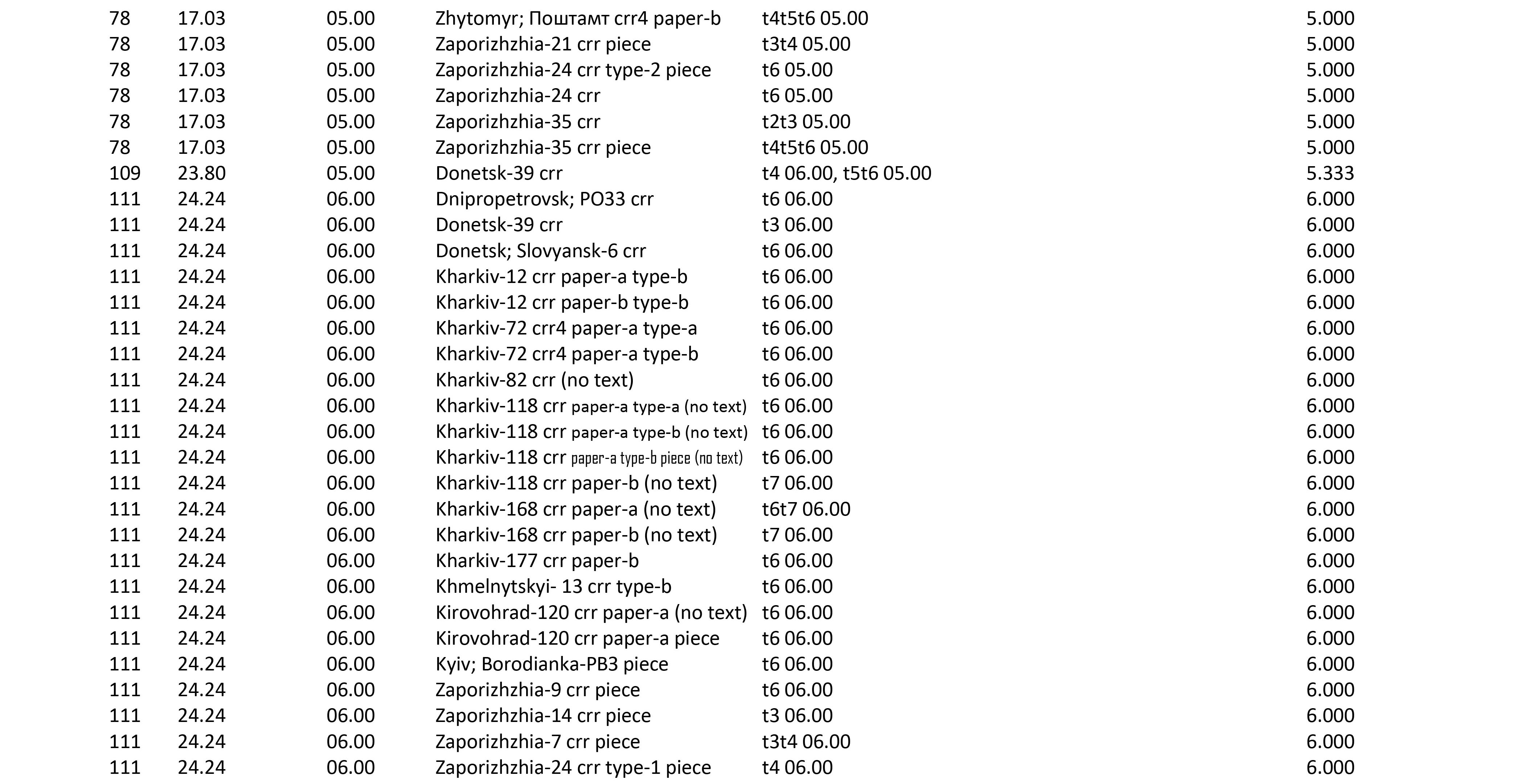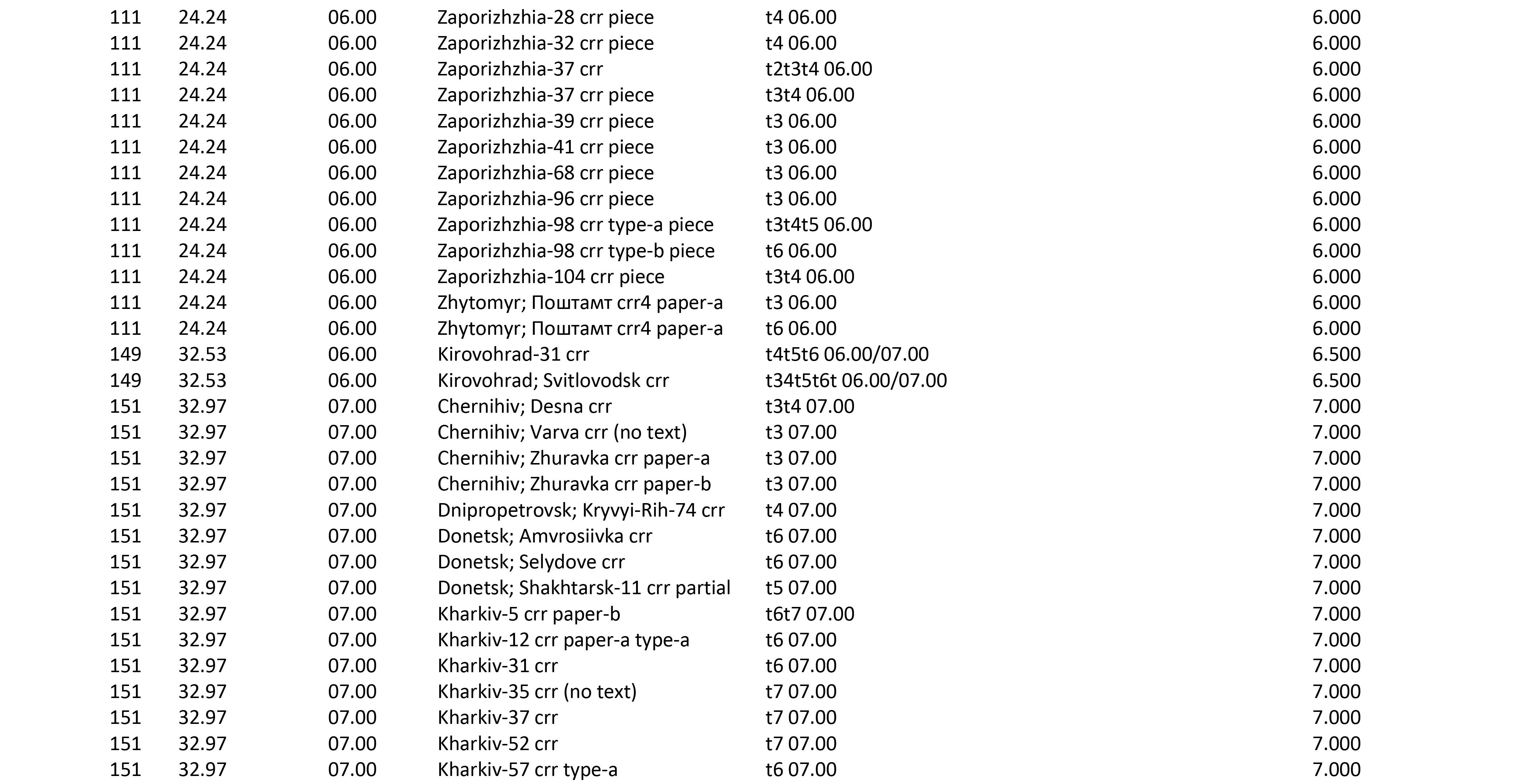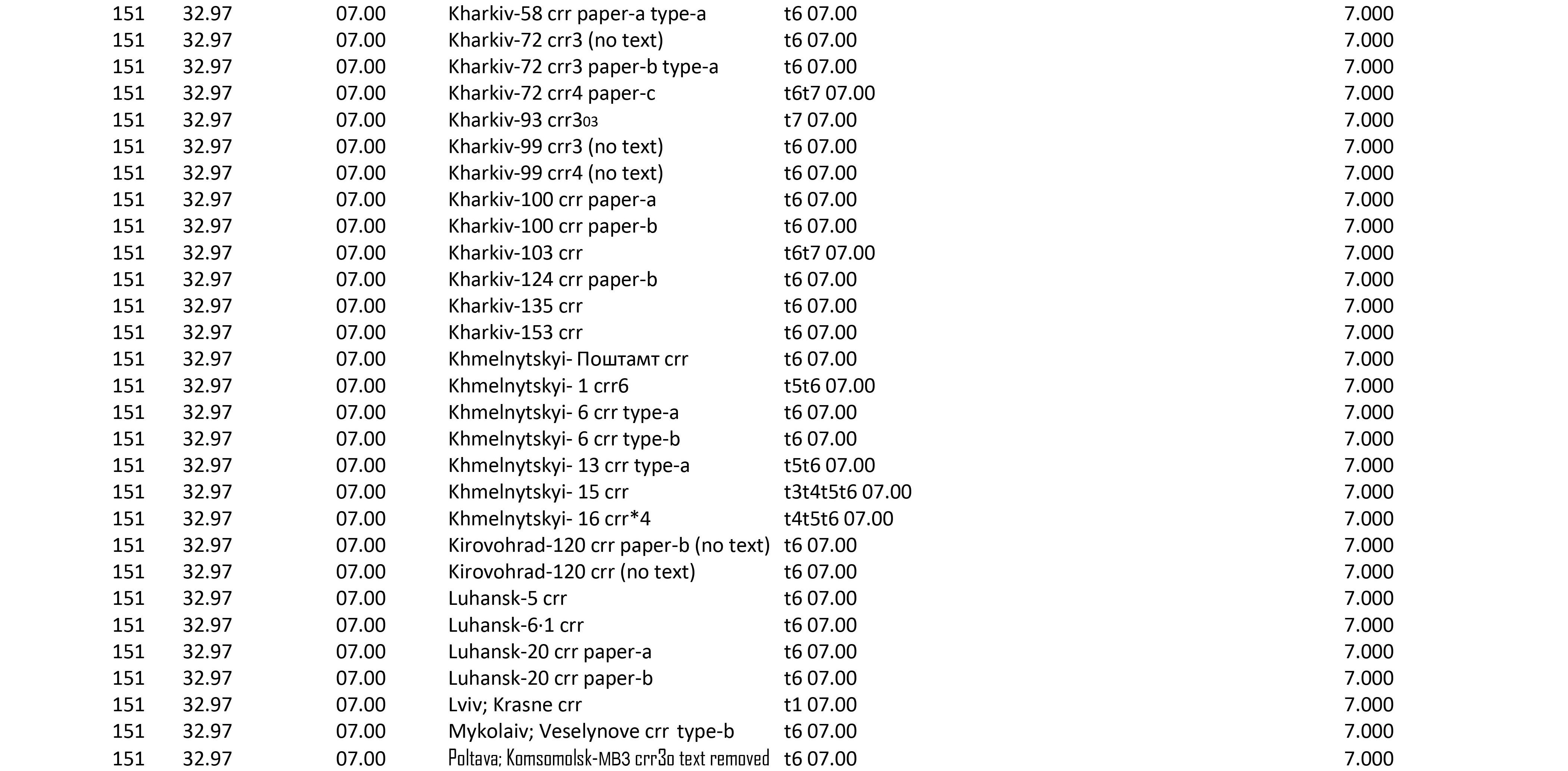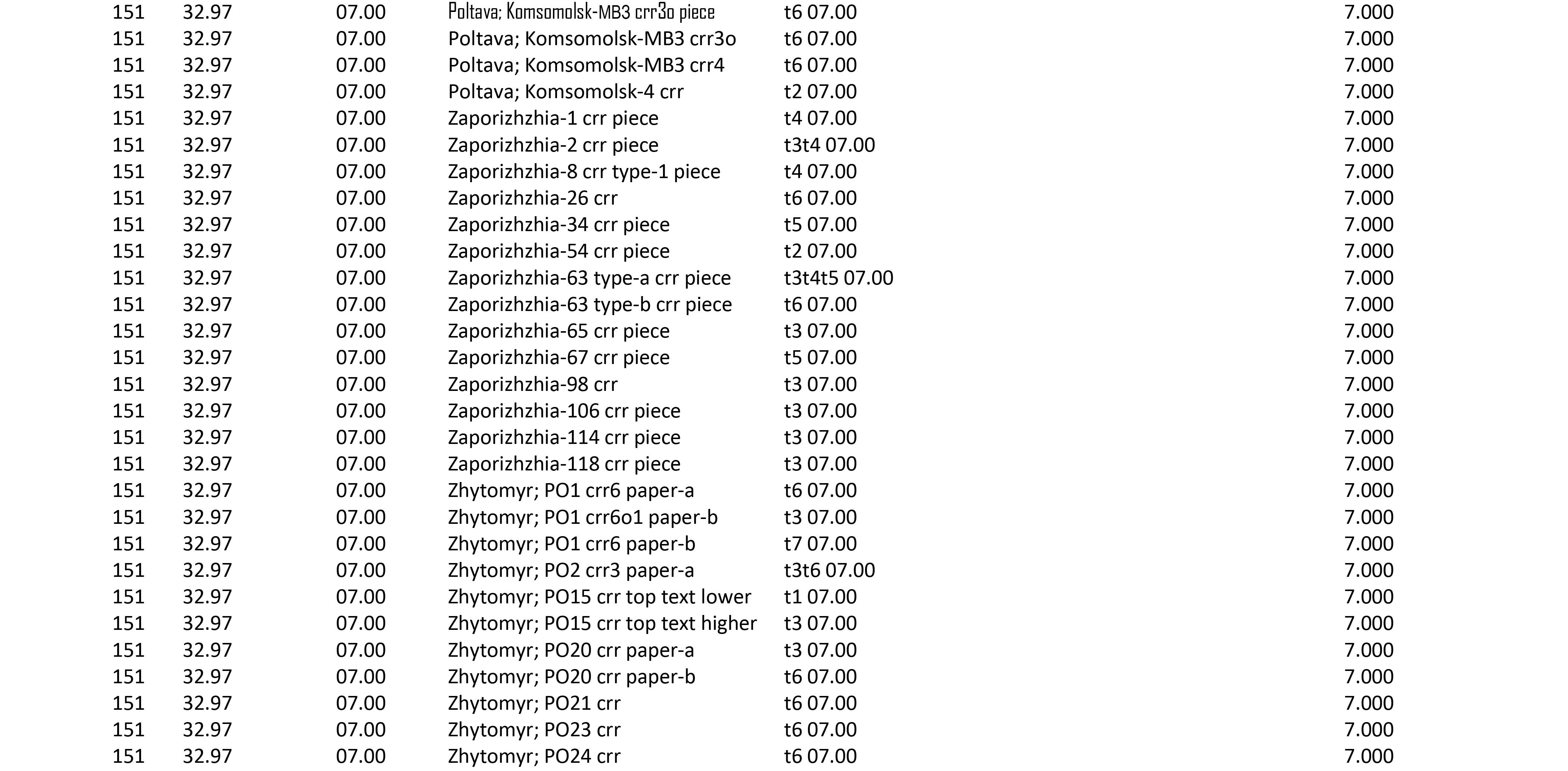The premise of this table is that the price of an item logically reflects its availability or lack thereof relative to others. Pricing based upon ‘Провизорные Выпуски Украины 1992-1999 гг.’ (‘Provisional Postage Stamps of Ukraine 1992-1999’), Third Edition, by Hryhoriy Lobko, ©2008, isbn 9789668550577;
Make sure to carefully read the ‘Notes’ section at the end, in order to best understand the data. For example, you will then find out that ‘t’ means ‘tariff’, why so many of them are clumped together (‘t2t3t4’ followed by a value common to all three of those tariffs), and so on for other details.
Then, outside of the data in general, concentrate specifically on the first two columns that form a data summary, the first that ranks each cover type in value order ‘1-to-458’ (there are lots of ‘ties’), the second that completes a percentage value for each given stamp in comparison to each other, and the last that does the same for covers. The higher the figure per item, the scarcer/rarer the cover, and in terms that are now quantified.
Lobko’s published pricing is in euros (EUR). Using the link ‘https://freecurrencyrates.com/en/exchange-rate-history/EUR-UAH/2007/cbr’, the year-2007, which is in-era to the catalogue’s publication, sights an exchange of anywhere as low as 6.5233UAH-to-1€ in January to as high as 7.5515UAH-to-1€ in November. For most of that year, it was around 6.75UAH-to-1€.
The choice is yours if you wish to convert (and if you wish to go further and calculate today’s price based upon accrued value since then).
In any case, the order of the table’s listings relative to each other would remain the same.
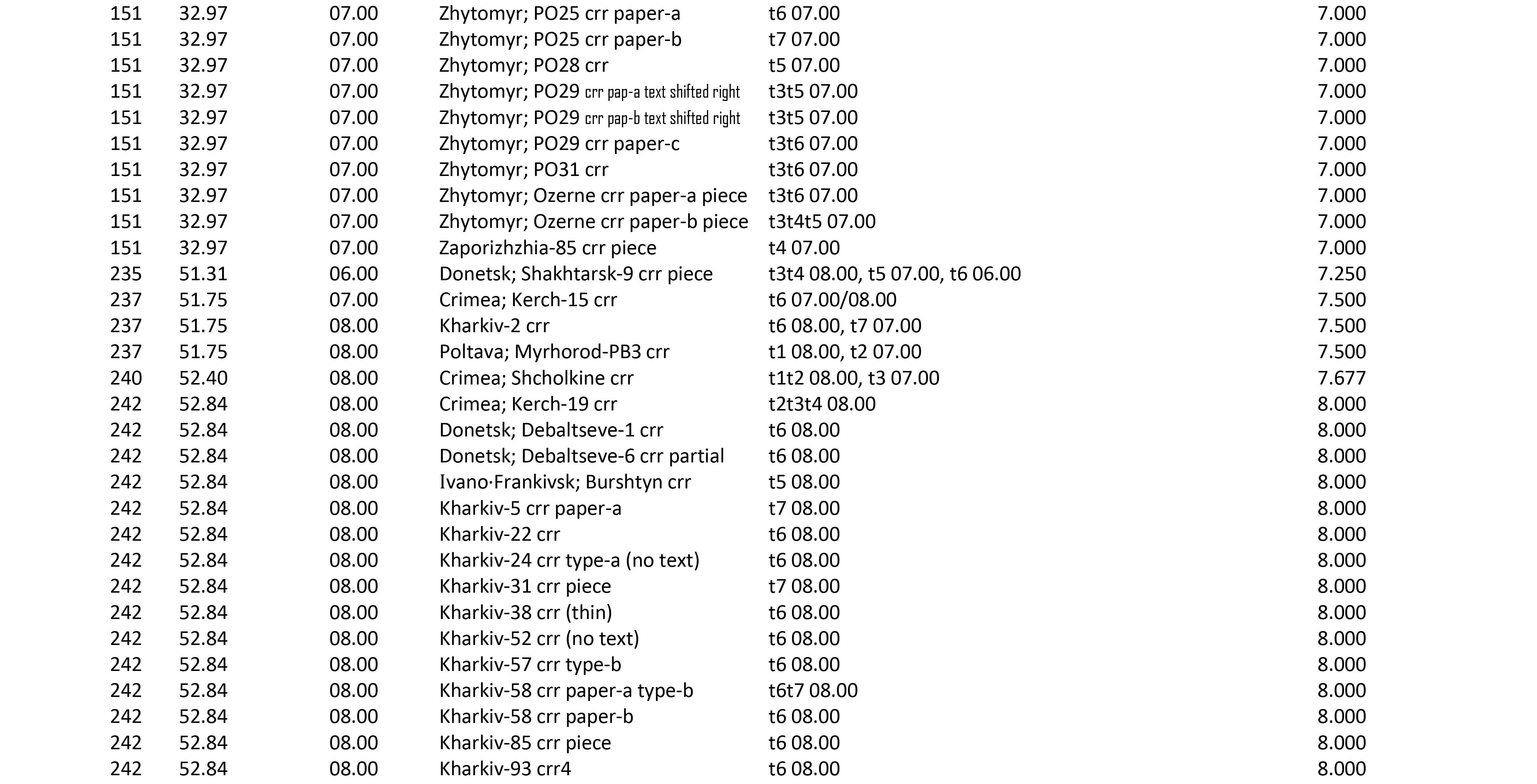
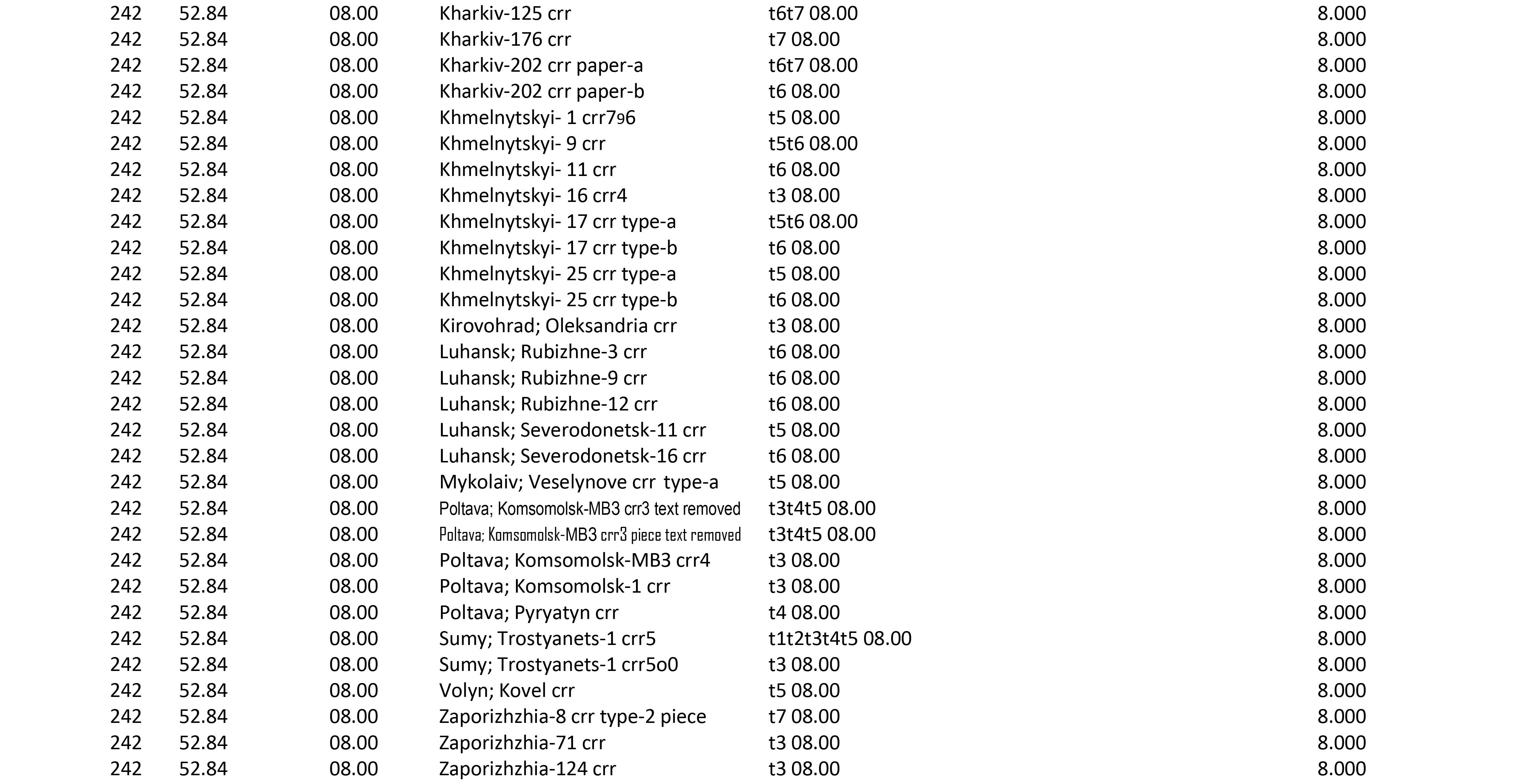
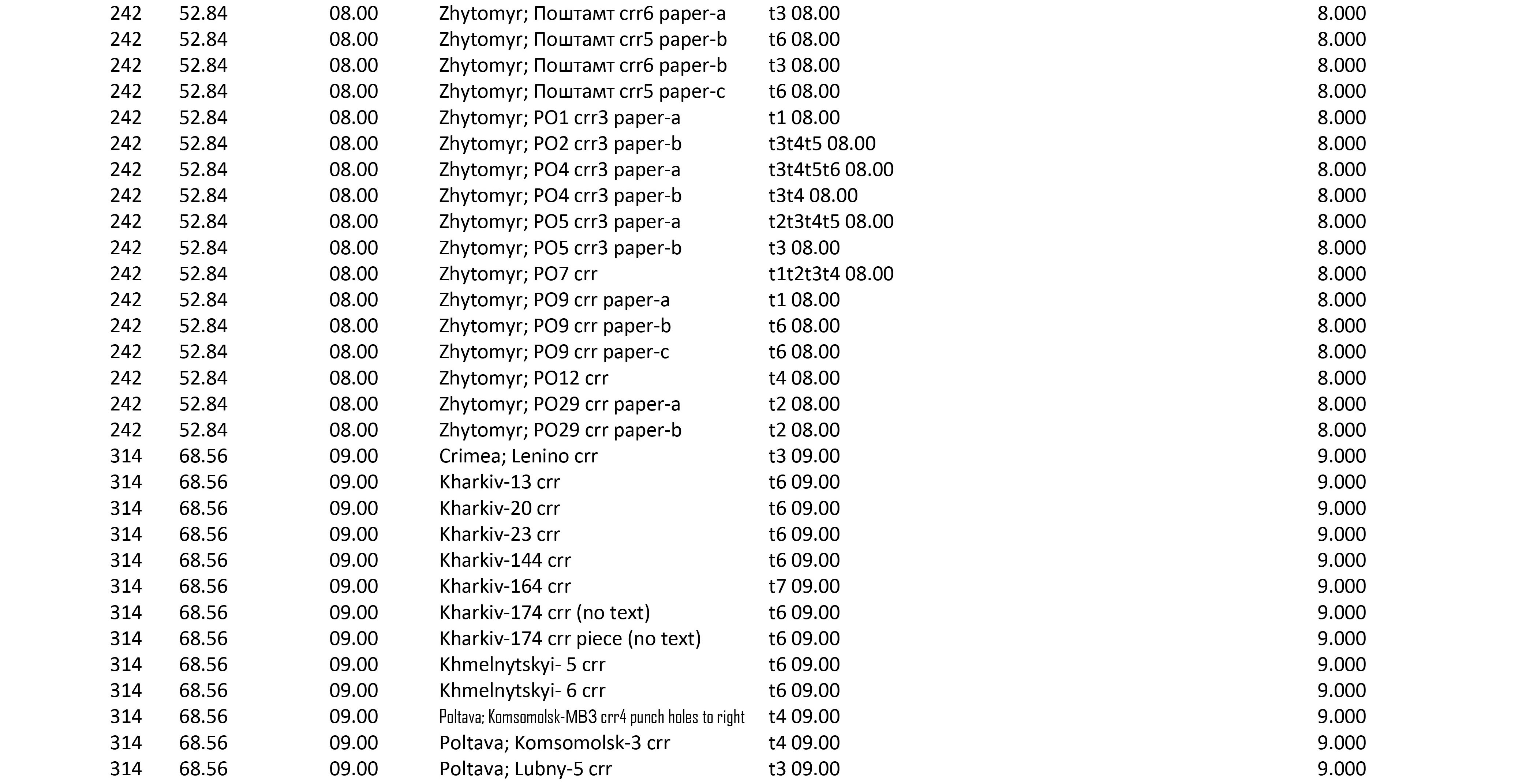

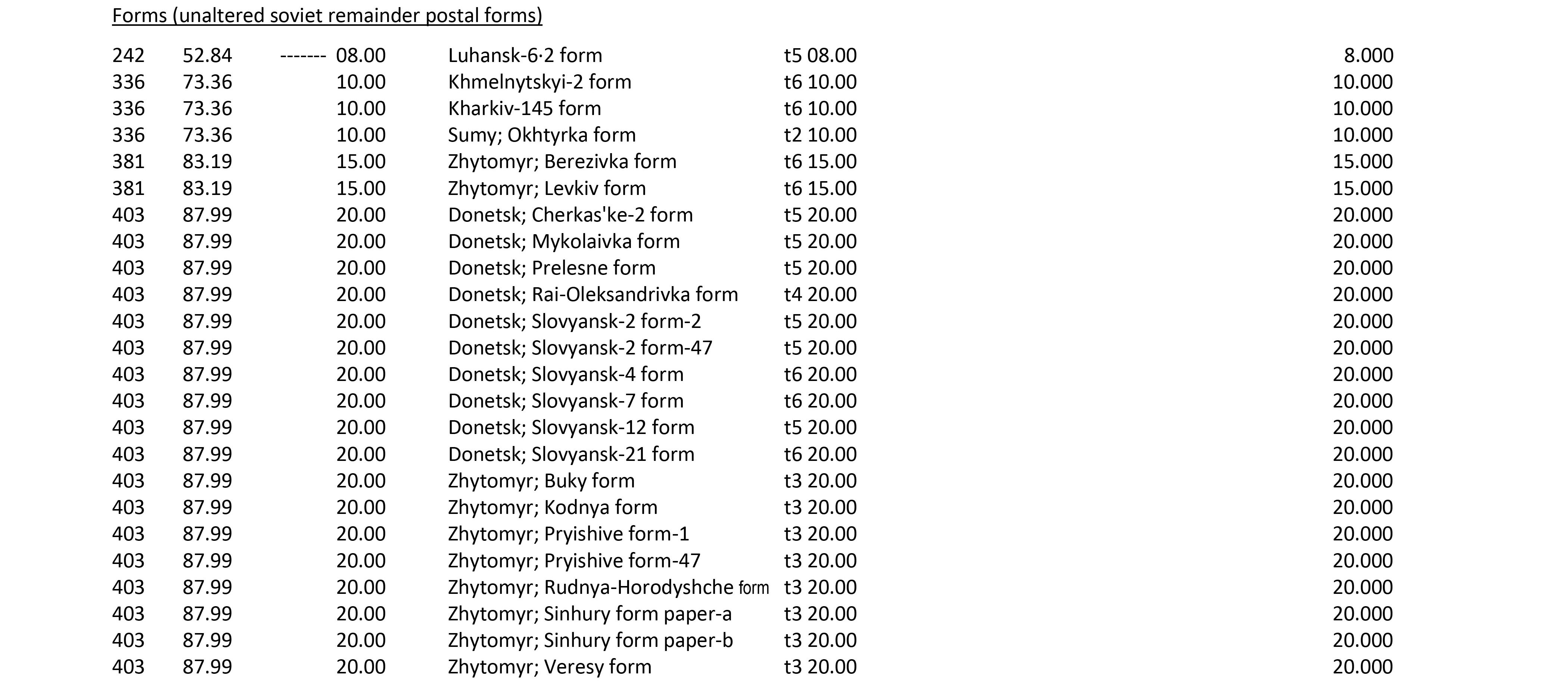

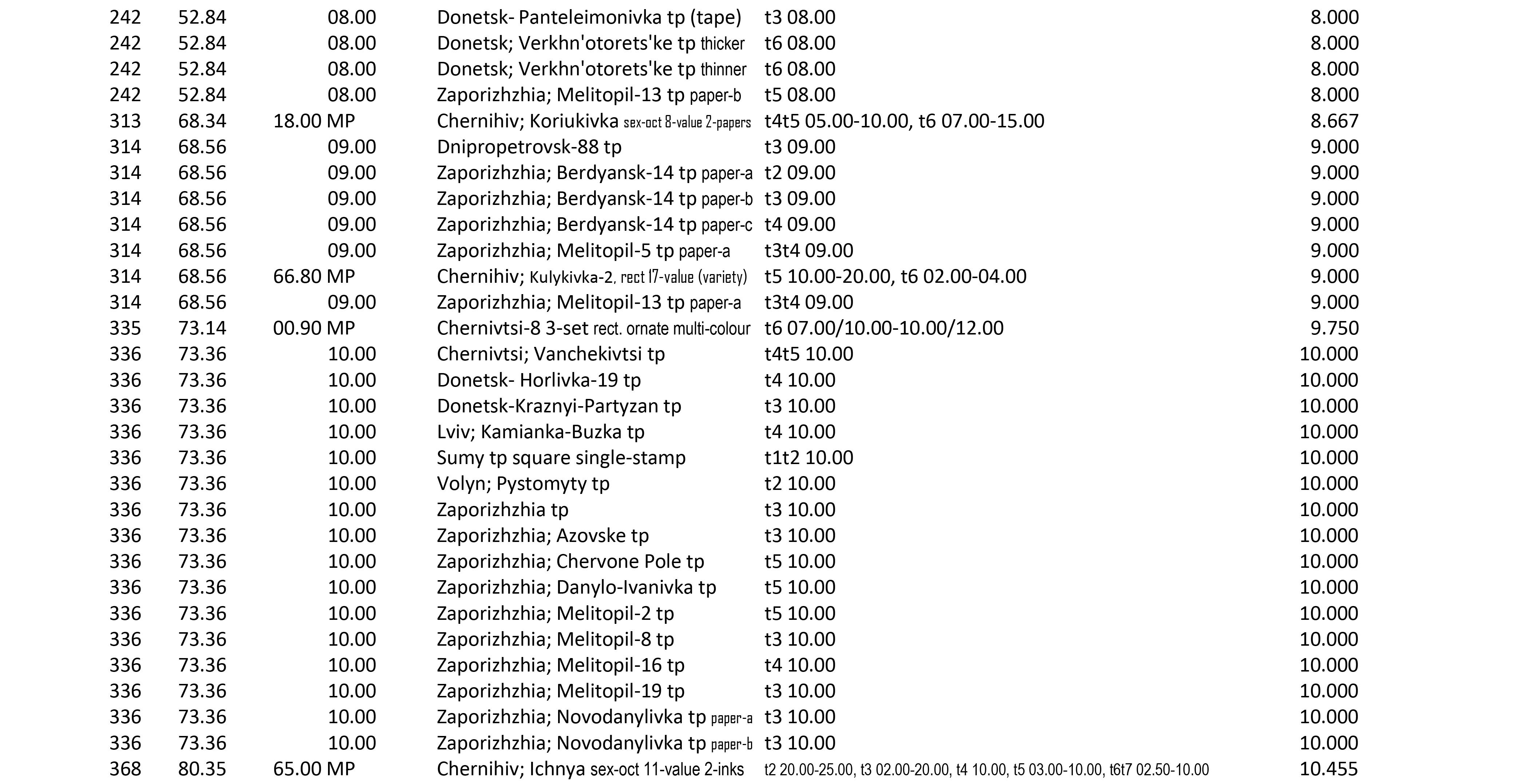
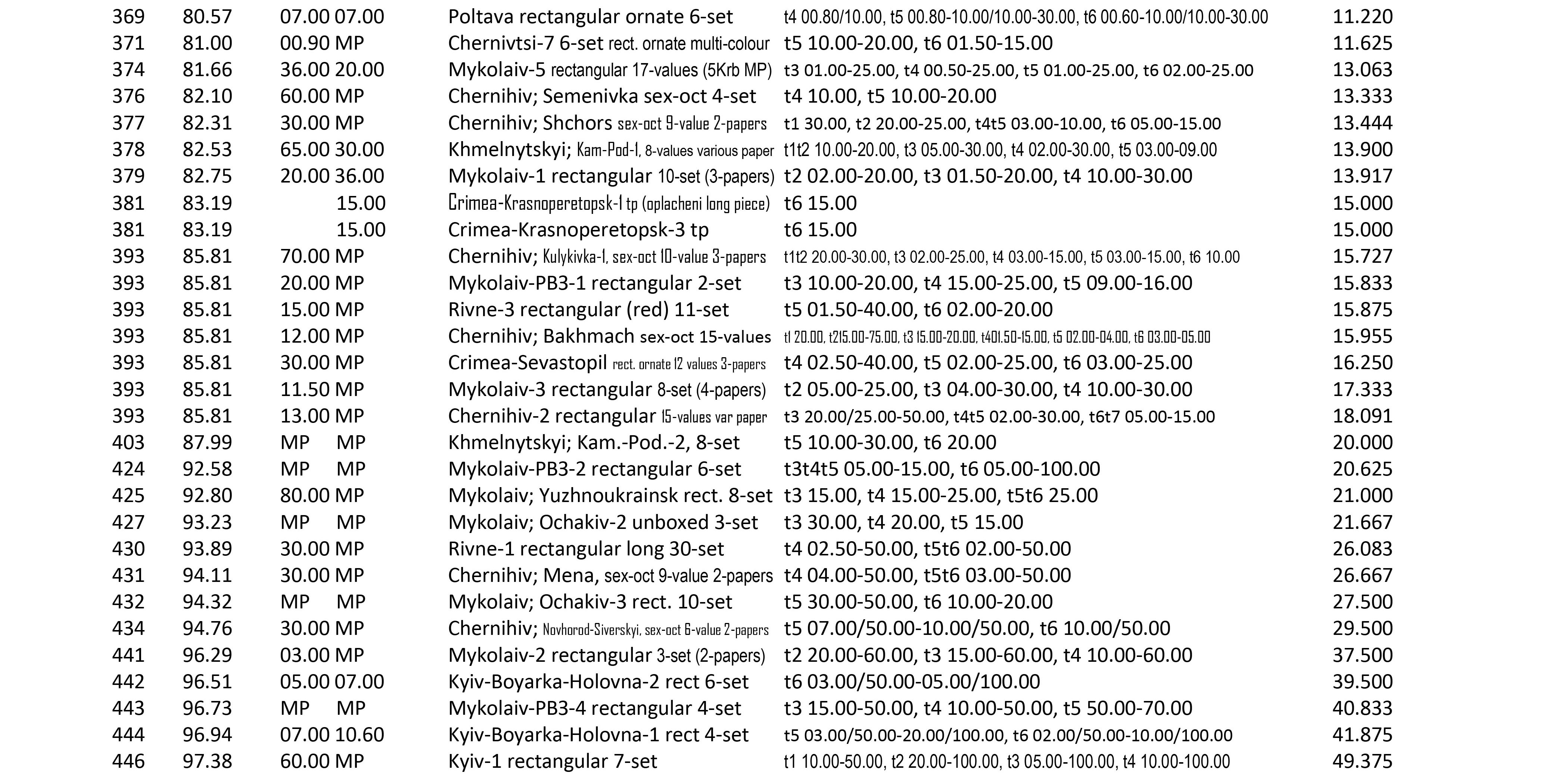


End Notes:
A variety of font types and sizes were used in order to ‘fit’ all of the notations and text;
Names used above are in-era to the genre;
Values as listed in ‘Lobko-3’ (©2010, isbn 9789668550577); of 458 entries, the highest ‘% Rank’ is 455 at ’99.35%’ since the last few are tied;
Under Local Revalues b: Utilitarians- 1/2/3: Italics indicates author entries: 1- ‘Chernihiv; blindly revalued surcharge’ cover average valuation shown as ’50.00’ based upon the possibility of three available surcharges (0.50, 1, and 3Krb); 2- ‘Odesa city PO-111 2k ussr pen man to 1Krb’ cover average valuation shown as ‘100.00’ based upon this being the only know genre example to date (Note: An example exists within another genre type); 3- the ‘revalued utilitarians’ covers are assigned a ‘2.285’ average cover valuation based upon Lobko-listed ‘Поштамт’ (mpo) examples;
There appears to be a ‘local’ (domestic) oriented valuation slant; It appears clear that the Lobko values are based upon ‘the most common case’; for example, the cover values for ‘Kyiv-Поштaмт-1 rectangular utilitarians’ are only 01.00 during ‘t1t2’; however this valuation is likely for domestic use, rather than international packages that are probably much higher in value due to scarcity;
Stamp sets: Since there are many cases where given stamps vary in value, I have decided to use the set valuation;
If only one value is shown, this value is common for both new and used and private and commercial;
If two values with a slash mark shown, first is private, second commercial; there are many times where this is ignored if the difference is minimal;
If two values are shown without a slash mark, the first is mint, the second is used;
The following given stamp types can only come used with legible dated in-era cancel for this genre: blind revalues, CRRs, forms, TPs, (and tps that appear to be on tape for telegraphs);
Covers values are often different according to tariff period use;
Surcharge and utilitarian stamps are shown as mint and used; you will see this, for example, as ’00.50/05.00’ (meaning ‘50k/5Krb’);
‘t3’ means tariff-3, ‘t1t2’ means tariffs 1 and 2, ‘t4t5t6’ means tariffs 4-5-6, and so on;
‘MP’ means ‘Market Price’, a term used in ‘Lobko-3’ for select issues/sets; (page-13 Lobko-3: the precise acronym is ‘ЦД’ stands for ‘Ціна Договорна’, pronounced ‘Tsina Dohovorna’ meaning ‘Negotiable Price’.); in the case of ‘used stamps’, the MP could be minimal; in the case of sets that have MP as the mint value, this is likely an indication of heavy cost and perhaps ‘exclusivity’ (very few collectors have it, perhaps only ‘the connected’);
‘Поштaмт’ is the given city’s ‘main post office’ (mpo);
CRR is ‘cash register receipt’, partial crr is ‘partial cash register receipt’ where the top ussr/russian language part has been snipped away with only the bottom part being used as the stamp (perhaps a way to ‘Ukrainianize’); a few crrs have no text and only the numbers;
TP means ‘taxe-perçue’; the majority are short and long; if otherwise, it is indicated;
Reading an entry:
i- The following demonstrates how to read one of the simplest:
314 68.71 ------- 09.00, Kharkiv-23 crr, t6 09.00:
314 (of 458 entries, puts it at …) 68.56% (fairly high in terms of ‘costliness/rarity’)
no mint value stamp (thus ‘-------’, or a blank) since this type must be ‘used’ in order to qualify for this genre; (used stamp valued at …) 9Krb; (local post office …) Kharkiv-23; (type of stamp is …) crr; (used during …) tariff-6; (cover price …) 9Krb;
ii- The following demonstrates how to read one of the more complex:
51 11.14 10.00 MP Donetsk- ПоштaмT-2 oct 16-set, t5 00.80-02.00/01.00-05.00, t6 00.80-03.00/01.00-05.00, 2.325:
51 (of 458 entries, puts it at …) 11.20% (quite low in terms of ‘costliness/rarity’)
set value 10.00 mint, and MP (market price) used, Donetsk- MPO-2, octangular 16-set, t5 00.80-02.00/01.00-05.00, t6 00.80-03.00/01.00-05.00’
cover price: tariff-5: private mail 80-kopiyoks to 2Krb depending upon stamp face value, commercial mail 1Krb to 5Krb depending upon stamp face
value, tariff-6: private mail 80-kopiyoks to 3Krb depending upon stamp face value, commercial mail 1Krb to 5Krb depending upon stamp face value;
2.325 is the average cost per cover.
